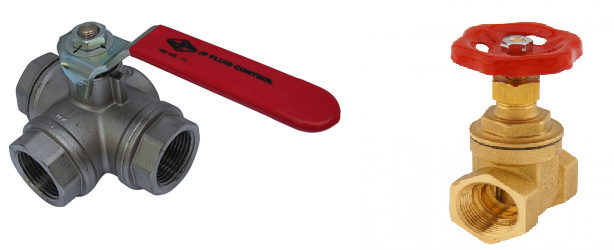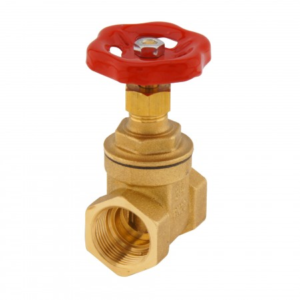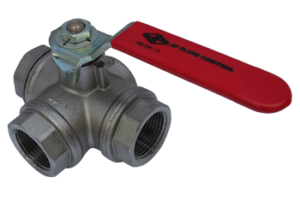Ball valves and gate valves are used to control the flow of liquids and gases, and they are used in various applications in different industries. A gate valve derives its name from the mechanism it uses to control the fluid through it. When lifted, the gate opens and permits the flow of fluid. And once you lower the gate, it restricts flow.
On the other hand, a ball valve derives its name from one of its components. That is, the ball inside the valve contains a hole, which restricts and permits the flow of fluid through it. When turned on, i.e., by a specific angle, the hole is parallel with the pipe, permitting flow. And when turned off, the hole is perpendicular to the pipe and thus restricts flow. A lever is used to control the movement of the ball. Hence, it acts as an on and off switch.
Gate Valves
The main components of a gate valve are the bonnet and the valve body. The bonnets are responsible for protecting the internal parts of a gate valve. Depending on the application, there are several types of bonnets. These include the screw-in bonnet, union bonnets, bolted bonnets, and pressure seal bonnets.
Screw-in bonnets feature a simple construction but are very durable. Bolted bonnets and pressure seal bonnets are both recommended for larger valves with high pressure. The union bonnets require some maintenance to protect the union nut from wearing out.
There are different materials used for gate valves, and you can pick one depending on your unique applications and needs. Here are some of the popular material types of gate valves:
- Brass Gate Valve – They are known to be durable and hence useful where corrosion is likely. They can also withstand high temperatures and are commonly used in manufacturing plants.
- PVC Gate Valves – They are not ideal for high-temperature and pressure systems but ideal for home applications.
- Stainless Steel Gate Valves – Commonly used in home drinking water systems as stainless steel won’t rust or contaminate the water.
Figure 1: Gate valve
Ball Valves
The operational differences between the two valves lie with their mode of operation. While a gate valve blocks fluid flow by moving up and down to close the opening, a ball valve rotates a ball with an orifice to permit or restrict fluid flow.
Gate valves come in varying designs and use cases. Popular material types include:
- PVC Ball Valves –These are affordable and flexible. They find application in areas not associated with high pressure and temperatures.
- Brass Ball Valves – These ball valves are resistant to high heat and pressure. Ideal for manufacturing applications.
- Bronze Ball Valves – Since they are not easily eroded by water, they are used in ships and other water vessels.
- Stainless Steel Ball Valves – Because of their strength, they find application in areas associated with high pressure and temperature. Also useful in areas with corrosive chemicals.
Figure 2: Ball valve
Advantages and Disadvantages of a Gate Valve
Some advantages of using a gate valve include cost reduction as it’s cheaper than a ball valve of the same specifications. Similarly, the slow opening and closing speed of a multi-turn gate valve reduces the risk of water hammering. Gate valve installation also demands less space compared to a ball valve.
When it comes to the disadvantages, gate valves are more prone to corrosion and damage. They also lack the visual clue necessary for faster operation. Hence it can be hard to operate for people with disabilities.
Advantages and Disadvantages of a Ball Valve
Ball valves, unlike gate valves, are more durable and reliable. They are also easy to use, hence suitable for people with disabilities. However, the ball valve requires more installation space. In high-pressure situations, the ball valve may cause water hammer conditions.
Gate and Ball Valve Applications
Both ball valves and gate valves are widely used in residential and industrial applications. Gate valves are commonly found in older piping systems and applications that do not require frequent shutoffs. Large water lines also use gate valves because they have fewer straight flow and flow restrictions. On the contrary, ball valves are often used in new hygiene systems that require frequent shutoffs. They also find applications in fire protection systems and marine applications.
Last but not least, gate valves are used in high-temperature and high-pressure environments. These include power plants, mining, and water treatment applications. Also, gate valves are used in slurry and viscous-medium applications due to their ease of cleaning and maintenance. Here, ball valves are undesirable since they are difficult to clean, and sludge particles can damage the spinning balls. They may also cause contamination and aren’t suitable for food, beverage, and pharmaceutical applications.
Choosing the Right Valve for Your Unique Needs
When choosing either of the two valves, there are a couple of factors you want to consider. These include the flow capacity, the opening and closing speed, and the cost. Generally, gate valves have larger diameters and allow for more fluid flow. And while they are cheaper, they require more maintenance and may not be economical in the long run. By choosing a ball valve, you enjoy faster closing and opening speeds..







Leave a Reply